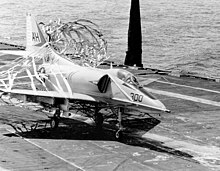
USS Oriskany (CV/CVA-34),, was one of the few Essex-class aircraft carriers completed after World War II for the United States Navy. The ship was named for the Battle of Oriskany during the Revolutionary War.

The Douglas A-4 Skyhawk is a single-seat subsonic carrier-capable light attack aircraft designed and produced by the American aerospace manufacturer Douglas Aircraft Company, and later, McDonnell Douglas. It was originally designated A4D under the United States Navy's pre-1962 designation system.

Strike Fighter Squadron 211 (VFA-211), nicknamed the "Fighting Checkmates", is an aviation unit of the United States Navy established in 1945. The squadron is based at Naval Air Station Oceana and is equipped with the Boeing F/A-18E Super Hornet.

Strike Fighter Squadron 146 (VFA-146) also known as the "Blue Diamonds" is a United States Navy operational fleet strike fighter squadron based at Naval Air Station Lemoore California. They fly the F/A-18E Super Hornet and are attached to Carrier Air Wing 17, deployed aboard USS Nimitz. Their tailcode is NA and their radio callsign is Diamond.

Strike Fighter Squadron 113 (VFA-113), also known as the "Stingers," is a United States Navy strike fighter squadron based at Naval Air Station Lemoore, California. They are an operational fleet F/A-18E Super Hornet squadron attached to Carrier Air Wing 2 (CVW-2) and based at NAS Lemoore, California. Their tailcode is NE and their radio callsign is Sting.

Strike Fighter Squadron 192 (VFA-192), also known as the "World Famous Golden Dragons", are a United States Navy F/A-18E Super Hornet fighter squadron stationed at NAS Lemoore.

Carrier Air Wing Eleven (CVW-11) is a United States Navy aircraft carrier air wing based at Naval Air Station Lemoore, California. The air wing is attached to the aircraft carrier USS Theodore Roosevelt.
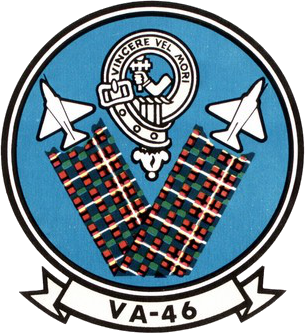
Attack Squadron 46 was an attack squadron of the United States Navy that was active during the Cold War. VA-46 was deactivated as part of the post-Cold War drawdown of forces on 30 June 1991.
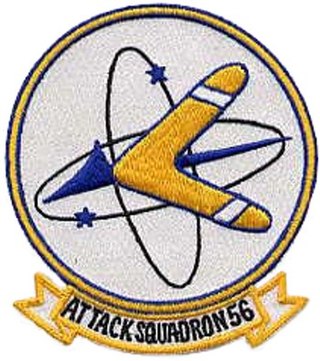
VA-56 was an Attack Squadron of the U.S. Navy. It was established on 4 June 1956, and disestablished thirty years later, on 31 August 1986. The squadron's nickname was the Boomerangs from 1957 to 1958, and the Champions thereafter.

Attack Squadron 72 (VA-72) was an aviation unit of the U.S. Navy. It was established as Bomber Fighter Squadron 18 (VBF-18) on 25 January 1945. The squadron was redesignated as Fighter Squadron 8A (VF-8A) on 15 November 1946, as VF-72 on 28 July 1948, and finally as VA-72 on 3 January 1956. It was disestablished on 30 June 1991.
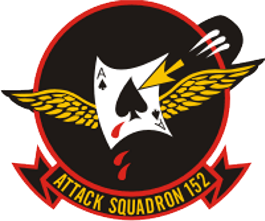
VA-152 was an Attack Squadron of the U.S. Navy, nicknamed the Fighting Aces from 1953-1956, the Friendly Squadron or Friendlies from 1957-1968, and the Mavericks thereafter.

VA-153 was an Attack Squadron of the U.S. Navy. During a 1949 reorganization of the Naval Air Reserve, a Fighter Squadron at NAS New York was redesignated Fighter Squadron VF-831. It was called to active duty on 1 February 1951. The squadron was redesignated as VF-153 on 4 February 1953, and finally as VA-153 on 15 December 1956. It was disestablished on 30 September 1977. The squadron's nickname was the Blue Tail Flies from 1953 onward.

Attack Squadron 155 or VA-155 was an 'Attack Squadron of the U.S. Navy. It was established as Reserve Attack Squadron VA-71E in 1946, redesignated as VA-58A on 1 October 1948, and redesignated Reserve Composite Squadron VC-722 on 1 November 1949. The squadron was redesignated as VA-728 on 1 April 1950, and called to active duty on 1 February 1951. It was ultimately redesignated VA-155 on 4 February 1953, and disestablished on 30 September 1977. Its nickname was Silver Fox from the early 1960s onward. It was the second squadron to be named VA-155, the first VA-155 was disestablished on 30 November 1949, while a third VA-155 was established on 1 September 1987 and disestablished on 30 April 1993.

VA-164, nicknamed the Ghostriders, was an Attack Squadron of the U.S. Navy. It was established on 1 September 1960 and disestablished on 12 December 1975.

VA-34, nicknamed the Blue Blasters, was an Attack Squadron of the U.S. Navy. The squadron was established as Fighter Squadron VF-20 on 15 October 1943, redesignated as VF-9A on 15 November 1946, as VF-91 on 12 August 1948, and as VF-34 on 15 February 1950. It was finally redesignated VA-34 on 1 July 1955. The squadron was disestablished on 1 June 1969. It was the second squadron to bear the VA-34 designation, the first one having been renamed VA-35 in 1950.
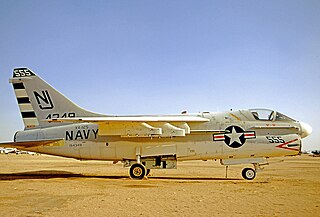
VA-125 was an Attack Squadron of the U.S. Navy, and was the second squadron to bear the VA-125 designation. It was established as VA-26 on 30 June 1956, and redesignated VA-125 on 11 April 1958. The squadron was disestablished on 1 October 1977. Its nickname was Skylanchers from 1956-1958, and Rough Raiders thereafter.

Attack Squadron 15 (VA-15), nicknamed the Valions, was an aviation unit of the United States Navy. It was established as Torpedo Squadron 4 (VT-4) on 10 January 1942, redesignated VA-2A on 15 November 1946, and finally redesignated VA-15 on 2 August 1948. The squadron was disestablished on 1 June 1969, after 27 years of service.
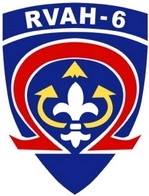
RVAH-6 was a Reconnaissance Attack (Heavy) Squadron of the U.S. Navy. Originally established as Composite Squadron Six (VC-6) on 6 January 1950, it was redesignated as Heavy Attack Squadron Six (VAH-6) on 1 July 1956 and was redesignated as Reconnaissance Attack (Heavy) Squadron Six (RVAH-6) on 23 September 1965. The squadron was disestablished on 20 October 1978.

RVAH-13 was a Reconnaissance Attack (Heavy) Squadron of the U.S. Navy. Originally established as Heavy Attack Squadron Thirteen (VAH-13) on 3 January 1961 it was redesignated as Reconnaissance Attack (Heavy) Squadron Thirteen (RVAH-13) on 1 November 1964. The squadron was disestablished on 30 June 1976.

Fighter Squadron 111 (VF-111), also known as the Sundowners, was a fighter squadron of the United States Navy. Originally established as Attack Squadron 156 (VA-156) on 4 June 1955, it was redesignated VF-111 on 20 January 1959, the day after the original VF-111 was disestablished. The squadron was redesignated VF-26 on 1 September 1964, redesignated as VF-111 on 17 September 1964 and disestablished on 31 March 1995.


